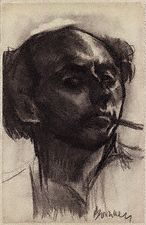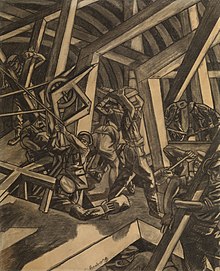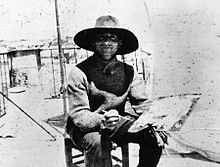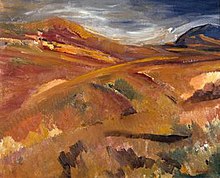Art by David Bomberg Art by Wyndham Lewis Ww1
| David Bomberg | |
|---|---|
 Photograph of David Bomberg, c.1925. | |
| Born | David Garshen Bomberg (1890-12-05)5 Dec 1890 Birmingham, England |
| Died | xix Baronial 1957(1957-08-xix) (aged 66) London, England |
| Education |
|
| Known for | Painting, drawing, teaching |
| Movement | Vorticism, Cubism, Futurism |
David Garshen Bomberg (v December 1890 – 19 August 1957) was a British painter, and ane of the Whitechapel Boys.
Bomberg was one of the most audacious of the exceptional generation of artists who studied at the Slade School of Art under Henry Tonks, and which included Mark Gertler, Stanley Spencer, C.R.W. Nevinson, and Dora Carrington.[i] Bomberg painted a series of circuitous geometric compositions combining the influences of cubism and futurism in the years immediately preceding World War I; typically using a express number of striking colours, turning humans into elementary, angular shapes, and sometimes overlaying the whole painting a strong grid-piece of work colouring scheme. He was expelled from the Slade Schoolhouse of Art in 1913, with agreement between the senior teachers Tonks, Frederick Brown and Philip Wilson Steer, because of the audacity of his breach from the conventional arroyo of that time.[ii]
Whether because his organized religion in the machine age had been shattered by his experiences as a individual soldier in the trenches or because of the pervasive retrogressive attitude towards modernism in United kingdom of great britain and northern ireland Bomberg moved to a more than figurative style in the 1920s and his piece of work became increasingly dominated by portraits and landscapes drawn from nature. Gradually developing a more than expressionist technique, he travelled widely through the Middle East and Europe.
From 1945 to 1953, he worked as a instructor at Borough Polytechnic (now London South Bank Academy) in London, where his pupils included Frank Auerbach, Leon Kossoff, Philip Holmes,[3] Cliff Holden, Edna Isle of man, Dorothy Mead, Gustav Metzger, Dennis Creffield, Cecil Bailey, and Miles Richmond.[4] David Bomberg House, one of the student halls of residences at London South Bank University, is named in his honour. He was married to landscape painter Lilian Holt.
Early years [edit]

Self-Portrait (1931), charcoal and wash.
Bomberg was born in the Lee Bank surface area of Birmingham on 5 December 1890.[5] He was the seventh of eleven children of a Polish Jewish immigrant leatherworker, Abraham, and his married woman Rebecca. He was Orthodox but she less and so and supported David's painting ambitions.[6] In 1895, his family moved to Whitechapel in the East Stop of London where he was to spend the rest of his babyhood.[7]
After studying art at Urban center and Guilds, Bomberg returned to Birmingham to railroad train as a lithographer[8] but quit to report under Walter Sickert at Westminster School of Art from 1908 to 1910. Sickert's emphasis on the study of grade and the representation of the "gross material facts" of urban life were an important early influence on Bomberg,[9] alongside Roger Fry's 1910 exhibition Manet and the Mail-Impressionists, where he first saw the piece of work of Paul Cézanne.[7]
Bomberg's artistic studies had involved considerable fiscal hardship but in 1911, with the assist of John Vocalist Sargent and the Jewish Didactics Aid Society, he was able to accomplish a identify at the Slade School of Art.[10]
The Slade [edit]

At the Slade School of Fine Fine art Bomberg was one of the remarkable generation of artists described by their drawing principal Henry Tonks equally the School's 2d and terminal "crisis of luminescence" and which included Stanley Spencer, Paul Nash, Ben Nicholson, Mark Gertler and Isaac Rosenberg.[1] (The "first crisis of brilliance" had occurred in the 1890s, with Augustus John, William Orpen and others.) Bomberg and Rosenberg, from similar backgrounds, had met some years earlier and became close friends every bit a upshot of their common interests.[2]
The emphasis in teaching at the Slade was on technique and draughtsmanship, to which Bomberg was well suited – winning the Tonks Prize for his drawing of fellow student Rosenberg in 1911.[xi] His ain way was rapidly moving abroad from these traditional methods, withal, especially under the influence of the March 1912 London exhibition of Italian Futurists that exposed him to the dynamic brainchild of Francis Picabia and Gino Severini, and Fry's 2nd Post Impressionist exhibition in October of the same yr, which displayed the works of Pablo Picasso, Henri Matisse and the Fauvists alongside those of Wyndham Lewis, Duncan Grant and Vanessa Bell.[12]
Bomberg'southward response to this became clear in paintings such equally Vision of Ezekiel (1912), in which he proved "he could absorb the nearly experimental European ideas, fuse these with Jewish influences and come up with a robust culling of his own."[x] His dynamic, angular representations of the homo form, combining the geometrical abstraction of cubism with the energy of the Futurists, established his reputation as a forceful member of the avant-garde and the most audacious of his contemporaries; bringing him to the attending of Wyndham Lewis (who visited him in 1912) and Filippo Marinetti. In 1913, the twelvemonth in which he was expelled from the Slade because of the radicalism of his approach, he travelled to France with Jacob Epstein, where amongst others he met Amedeo Modigliani, André Derain and Pablo Picasso.[xiii]
Pre-war avant-garde [edit]

Expelled from the Slade in the Summer of 1913, Bomberg formed a series of loose affiliations with several groups involved with the gimmicky English language avant-garde, embarking on a brief and acrimonious association with the Bloomsbury Grouping'south Omega Workshops before exhibiting with the Camden Town Group in December 1913. His enthusiasm for the dynamism and aesthetics of the auto age gave him a natural affinity with Wyndham Lewis's emerging vorticist movement, and five of his works featured in the founding exhibition of the London Group in 1914.[7] All the same, Bomberg was staunchly independent and despite Lewis' attempts he never officially joined Vorticism.[v] In July 1914 he refused involvement with the Vorticist literary magazine Smash and in June of the following year his work featured but in the "Invited to show" department of the vorticist exhibition at London's Dore Gallery. In 1914 he met his starting time married woman Alice Mayes a resourceful and practical woman about ten years older than him who had worked with Kosslov's Ballet Visitor. Their mutual interest in experimental trip the light fantastic and the Russian ballet may take helped bring them together. Alice helped Bomberg in the early part of his career both with financial back up and in influencing his appearance and grapheme. 1914 saw the highpoint of his early on career – a solo exhibition at the Chenil Gallery in Chelsea which attracted positive reviews from Roger Fry and T. E. Hulme and attracted favourable attention from experimental artists nationally and internationally.[10] The exhibition featured several of Bomberg'south early masterpieces, almost notably The Mud Bath (1914), which was hung on an outside wall surrounded past Union Flags – causing "the horses cartoon the 29 motorcoach... to shy at information technology equally they came round the corner of Male monarch's Road."[12]
"I await upon Nature while I live in a steel urban center" he explained in the exhibition catalogue "I Appeal to a Sense of Form ... My object is the construction of Pure Form. I reject everything in painting that is not Pure Class."[10]
With the help of Augustus John, Bomberg sold two paintings from this exhibition to the influential American collector John Quinn.[13] Alice and David enjoyed a trip to Paris with the proceeds of the sale of several pictures in 1914 which led to them marrying in 1916 afterwards Bomberg had enlisted in the Majestic Engineers in November 1915.
World War I and after [edit]


Photograph of David Bomberg, taken in Jerusalem, 1924.
Despite the success of his Chenil Gallery exhibition Bomberg continued to be dogged by financial problems. In 1915, he enlisted in the Royal Engineers, transferring in 1916 to the Male monarch'southward Royal Rifle Corps and in March of that yr, shortly after marrying his first wife, being sent to the Western Front end.[7]
World War I was to bring a profound modify to Bomberg's outlook. His experiences of its mechanized slaughter and the death of his blood brother in the trenches – every bit well equally those of his friend Isaac Rosenberg and his supporter T. E. Hulme – permanently destroyed his faith in the aesthetics of the machine age.[12] This can be seen almost conspicuously in his committee for the Canadian War Memorials Fund, Sappers at Work (1918–1919): his first version of the painting was dismissed as a "futurist ballgame" and was replaced by a 2d far more representational version.[xiii]
The artist's book Russian Ballet, 1919, was the terminal work to utilize the pre-war vorticist idiom. Bomberg self-published this work whilst waiting for the Canadian Government's verdict on Sappers at Work; the next few years was to see him 'experimenting with ways of making his stark pre-war style more rounded and organic'.[7]
In radical opposition to the prevailing currents in avant-garde art, stimulated equally these were by the enthusiasm for mechanization in Constructivism in Russia following the Revolution, Bomberg went to paint and draw in Palestine between 1923 and 1927, with the assistance of the Zionist Organization. There he brought together the geometric energies of his pre-war work as an "English cubist" with the tradition of figurative observation of the English landscape school of Turner, Constable, Girtin and John Sell Cotman.
The return to club [edit]

From at that place followed Bomberg'due south bang-up menstruation of painting and drawing in landscape, in Spain at Toledo (1928), Ronda (1934–35 and 1954–57) and Asturias (1935), in Cyprus (1948) and intermittently in Britain, perhaps almost powerfully in Cornwall. A vi-month stay at Odessa in the Soviet Union in the 2d half of 1933, following Hitler's seizure of ability in Frg, led Bomberg on his return to London to immediate resignation from the Communist Political party. During World War II, he painted Evening in the Urban center of London (1944), showing the blitzed city viewed rising up to a triumphant, surviving St Paul's Cathedral on the horizon, since described as the "nearly moving of all paintings of wartime Great britain" (Martin Harrison); a series of flower paintings saturated with turbulent feeling; and his unmarried commission every bit a war artist, a series of "Bomb Store" paintings (1942) expressing Bomberg'due south expanded showtime-hand sense of the destructive powers of modern engineering in warfare. These "Flop Store" paintings convey a premonitory sense of the massive explosion that destroyed the secret store ii years after, killing 68 people, and bear comparison with Piranesi'south Carceri etchings.
Bomberg'south superb draughtsmanship was expressed also in a lifelong series of portraits, from the early on period of his Botticelli-like "Caput of a Poet" (1913), a pencil portrait of his friend the poet Isaac Rosenberg for which he won the Henry Tonks Prize at the Slade, to his "Last Self-Portrait" (1956), painted at Ronda, a meditation also on Rembrandt.
Unable to get a teaching position after Globe War II in any of the well-nigh prestigious London art schools, Bomberg became the nigh exemplary teacher of the immediate mail service-war period in Britain, working part-time in a bakery school at the Borough Polytechnic (now London South Bank University) in the working-class civic of Southwark. Though his students received no grant and were awarded no diploma, he attracted devoted and highly energetic pupils, with whom he exhibited on an equal basis in London, Oxford, and Cambridge in ii important artists' groupings in which he was the leading light, the Borough Group (1946–51) and the Civic Bottega (1953–55). He developed a securely considered philosophy of art, prepare out in several pieces of writing, which he summed up in the phrase, "The Spirit in the Mass".
Post-obit a plummet in Ronda, Bomberg died in London in 1957, his critical stock rising sharply thereafter. One of Bomberg's admirers, the painter Patrick Swift, unearthed and edited Bomberg'south pensées, and was later to publish them, along with images of Bomberg'southward work, every bit 'The Bomberg Papers' in his 'X' magazine (June 1960).[14] Afterwards his early on success before the First Earth War, he was in his lifetime the nearly brutally excluded artist in Britain. Having lived for years on the earnings of his 2d married woman, fellow artist Lilian Holt and remittances from his sister Kitty, he died in absolute poverty.
Posthumous reception [edit]
Xxx years afterward his death, a major retrospective of Bomberg's work curated past Richard Cork was held at the Tate Gallery, London, in 1988.[15]
In 2006, Abbot Hall Art Gallery in Kendal, Cumbria, mounted the first major exhibition of Bomberg's paintings for nearly twenty years: David Bomberg: Spirit in the Mass (17 July – 28 October 2006).[9] Prior to that, the exhibition David Bomberg en Ronda at the Museo Joaquin Peinado in Ronda in Andalusia (ane–thirty October 2004) showed work by Bomberg in the city and environs which he had historic in paintings and drawings in 1934-35 and 1954–57. Piece of work from 1 of the all-time collections in individual easily was shown on the fiftieth anniversary of his death in the exhibition In celebration of David Bomberg 1890-1957 at Daniel Katz Gallery, Sometime Bond Street, London (xxx May – 13 July 2007).[16]
London South Bank University, the site of Bomberg'due south education at the former Civic Polytechnic, received a gift of more than 150 paintings and drawings past Bomberg and his students in the Borough Group – principally Dorothy Mead, Cliff Holden, Miles Richmond, and Dennis Creffield — the David Bomberg Legacy.[17] The gallery, formally launched on xiv June 2012, to display the artworks donated to the university by Sarah Rose has been fabricated possible by the Heritage Lottery Fund.[eighteen] The collection is the work of Sarah Rose, who congenital her collection over thirty years.[18] The London South Banking concern University Borough Road Gallery volition agree 2 exhibitions a twelvemonth fatigued from the Sarah Rose drove.
The Nasher Museum of Art at Duke University held an exhibition entitled The Vorticists: Rebel Artists in London and New York, 1914-18 from 30 September 2010 through ii Jan 2011.[19] Tate Great britain held an exhibition entitled The Vorticists: Manifesto for a Modernistic World between 14 June and 4 September 2011. In the 2011 BBC serial, British Masters, Bomberg was singled out as beingness one of the greatest painters of the 20th Century. He was one of the six artists included in Dulwich Motion picture Gallery's 2013 summer exhibition, "Nash, Nevinson, Spencer, Gertler, Carrington, Bomberg: A Crisis of Luminescence, 1908-1922".[20]
In 2017 the Pallant Firm Gallery in Chichester mounted a major exhibition of Bomberg'south work curated in partnership with the Ben Uri Gallery & Museum of St John'southward Wood, London.[21]
References in fiction [edit]
In Restless, William Boyd'southward 2006 novel, there is a reference to a portrait past Bomberg of i of the book'southward major (fictional) characters. The painting is said to occupy a place in the National Portrait Gallery in London. In A Palestine Affair, a 2003 novel by Jonathan Wilson, the character "Mike Bloomberg" is loosely based on Bomberg's life, equally acknowledged by the author: "Richard Cork's 'David Bomberg' [was] ... of inestimable value to me in constructing this fiction". Glyn Hughes'due south novel, Roth (Simon & Schuster, London, 1992) – its leading a character a London Jewish painter, its comprehend conveying a reproduction of one of Bomberg'southward Cyprus landscapes – is also loosely based on the writer's reflections on Bomberg.
References [edit]
- ^ a b David Boyd Haycock (2009). A Crunch of Brilliance: Five Immature British Artists and the Great State of war. Old Street Publishing (London). ISBN978-ane-905847-84-half-dozen.
- ^ a b Jean Moorcroft Wilson — Isaac Rosenberg (2008)
- ^ Hughes, Robert (1990). Frank Auerbach. p. 30. ISBN0-500-09211-vii. Archived from the original on one Nov 2016. Retrieved 12 December 2014. Philip Holmes' website]
- ^ Miles Richmond's website Archived 2 Oct 2016 at the Wayback Automobile
- ^ a b "David Bomberg" Archived ii Feb 2014 at the Wayback Automobile Retrieved 29 Jan 2014.
- ^ "David Bomberg: an Due east Terminate childhood" world wide web.tandfonline.com [ permanent dead link ]
- ^ a b c d e Cork, Richard (May 2006). "Bomberg, David Garshen (1890–1957)". Oxford Dictionary of National Biography (Online ed.). Oxford: Oxford University Printing. doi:10.1093/ref:odnb/37206. Retrieved xviii January 2008.
- ^ "The creative person David Bomberg". Digital Ladywood. Archived from the original on 21 July 2011. Retrieved 19 January 2008.
- ^ a b Cork, Richard (2006). "David Bomberg: Spirit in the Mass". Abbot Hall Art Gallery, Kendal. Archived from the original on 24 September 2007. Retrieved nineteen January 2008.
- ^ a b c d Cork, Richard. "David Bomberg". Tate. Retrieved 18 January 2008.
- ^ "David Bomberg biography". Marker Barrow Fine art. Archived from the original on 27 September 2007. Retrieved 19 January 2008.
- ^ a b c Hubbard, Sue (iv September 2006). "Dorsum in the frame". The Independent. Detect Articles at BNET.com. Retrieved 19 January 2008. [ dead link ]
- ^ a b c Raynor, Vivien (25 September 1988). "A Neglected British Genius". The New York Times . Retrieved 20 Jan 2008.
- ^ David Bomberg, 'The Bomberg papers', X, Vol. I, No. 3 (June 1960); An Album from 10, Oxford Academy Press (1988)
- ^ Cork, Richard "How I Discovered Bomberg" Archived iv March 2016 at the Wayback Car Borough Road Gallery, Retrieved 29 January 2014.
- ^ Haden-Guest, Anthony "Modernist in Motion" The Fiscal Times, Retrieved 29 January 2014.
- ^ "A Lasting Legacy" (PDF). Continued. 6: 11–13. Spring 2009. Archived from the original (PDF) on 7 August 2011.
- ^ a b "Borough Road Gallery" Archived 1 February 2014 at the Wayback Auto The Public Catalogue Foundation, Retrieved 29 January 2014.
- ^ Nasher Museum Archived 8 March 2013 at the Wayback Machine Retrieved 17 September 2010
- ^ "Nash, Nevinson, Spencer, Gertler, Carrington, Bomberg: A Crunch, 1908-1922" Dulwich Movie Gallery, Retrieved 29 Jan 2014.
- ^ Hudson, Mark (30 Oct 2017). "Welcome catch-up with a brilliant but awkward outsider - Bomberg". The Daily Telegraph.
Further reading [edit]
- David Bomberg 1890–1957: Paintings and Drawings, Tate Gallery, London, Arts Quango of Corking United kingdom (organizer), 1967. (Exhibition catalogue.)
- Roy Oxlade, David Bomberg, 1890–1957. London: Purple College of Art, 1977. ISBN 0-902490-23-0.
- Nicholas Serota and Jennifer Brook (editors), David Bomberg: the Later Years. London: Whitechapel Art Gallery, 1979. (Exhibition catalogue.) ISBN 0-85488-045-three.
- David Bomberg in Palestine, 1923–1927. Curator in charge, Stephanie Rachum; assistant curator, Hedva Raff; English editing, Barbara Gingold. Jerusalem: Israel Museum, 1983. (Exhibition catalogue.) ISBN 965-278-015-4.
- David Bomberg, 1890–1957: a Tribute to Lilian Bomberg, March 14 – April 12, 1985. London: Fischer Fine Art Ltd. Uxbridge, Middlesex: Hillingdon Printing, 1985.
- Kate Aspinall, 'Artist Versus Teacher: The Problem of David Bomberg'southward Pedagogical Legacy', Tate Papers, no.33, 2020, https://www.tate.org.britain/research/publications/tate-papers/33/artist-versus-instructor-problem-david-bomberg-pedagogical-legacy
- Richard Cork, David Bomberg. Yale, 1987. ISBN 0-300-03827-five.
- David Bomberg: Spirit in the Mass; Abbot Hall Art Gallery, Kendal, 17 July – 28 October 2006. Lakeland Arts Trust, 2006. (Exhibition catalogue.) ISBN i-902498-28-3.
- David Bomberg en Ronda; Museo Joaquin Peinado, Ronda, 1–30 October 2004. Museo Joaquin Peinado, 2004. (Exhibition catalogue with text by Richard Cork and Michael Jacobs.) ISBN 0-9545058-1-6.
- In Celebration of David Bomberg 1890–1957; Daniel Katz Gallery, London, 30 May – 13 July 2007. Daniel Katz Ltd, 2007. (Exhibition catalogue with text by Richard Cork and Miles Richmond.) ISBN 978-0-9545058-5-1
- Jean Moorcroft Wilson, Isaac Rosenberg: The Making of a Great State of war Poet. London: Weidenfeld and Nicolson, 2008. ISBN 978-0-297-85145-5.
- The Bomberg Papers (Bomberg's pensées; unearthed and edited past Patrick Swift), X, Vol. 1, No. 3, June 1960; An Anthology from X (Oxford University Press 1988).
- Bomberg Sarah MacDougall & Rachel Dickson, Ben Uri Gallery and Museum, London 2017 ISBN 978-0900157615
External links [edit]
- Works by or about David Bomberg at Internet Archive
- 128 artworks by or later on David Bomberg at the Art UK site
- Commodity on the Whitechapel Boys
- Guardian review of Abbot Hall exhibition
- Laurie Stewart, Notes on the Borough Group of Artists
- Cliff Holden, The History of the Civic Group of Artists, 2004
- Connected, Spring 2009, Journal of alumni of London Due south Bank Academy
Source: https://en.wikipedia.org/wiki/David_Bomberg
0 Response to "Art by David Bomberg Art by Wyndham Lewis Ww1"
Post a Comment